Busman Acetal Soprano D whistle Review
(Review written January 2006)
- Preface
- It's hard to believe it's been nearly three years! I last reviewed a Busman in June of 2003, back when I was still somewhat new at this. I was happy to check out Paul's newest creation when he announced that he was sending one on tour.
- At a Glance
- Whistle Reviewed
- Busman Acetal Soprano D whistle
- Models Available
- C, D, D+ and Eb in hardwood or acetal
- How Acquired
- Whistle Tour
- Construction
- Green, yellow or black acetal with brass (or stainless) fittings
- Price at Time of Review (in US Dollars unless otherwise noted)
- $250.00
- Available From
-
Busman Whistles
- Appearance
- At a glance, the whistle looks like a blackwood version of the Cocobolo Busman I reviewed back in 2003. The fittings on this one are brass (though stainless is available), and Acetal isn't really as shiny as a well-polished blackwood whistle, but at a distance, I imagine no one will be able to tell the difference. Close-up, there are some differences in quality. I imagine acetal doesn't drill as cleanly as wood, as the tone-holes are a little gouged looking. Delrin doesn't really like anything to stick to it either...the metal part of the mouthpiece and the internal tubing for the tuning slide both had come loose by the time I'd gotten the whistle (I was the third whistler to have the whistle on the tour).
-
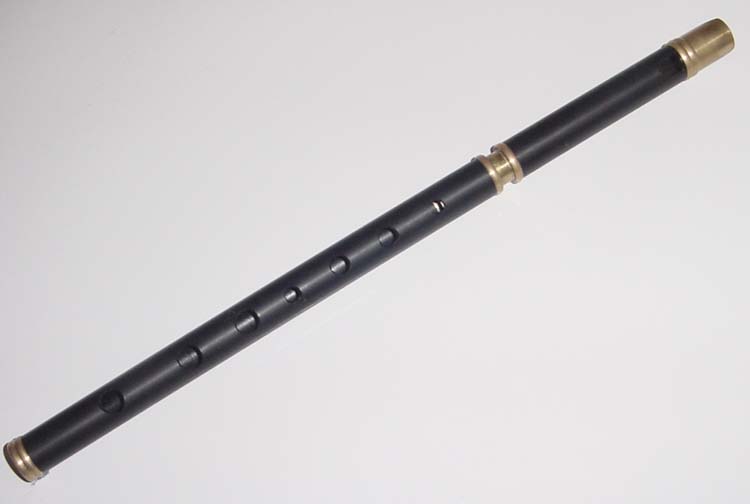
Here's the full whistle.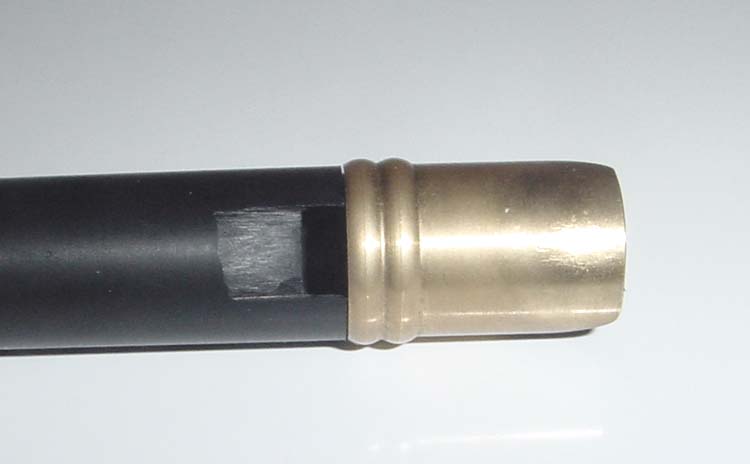
Here's a close-up of the mouthpiece.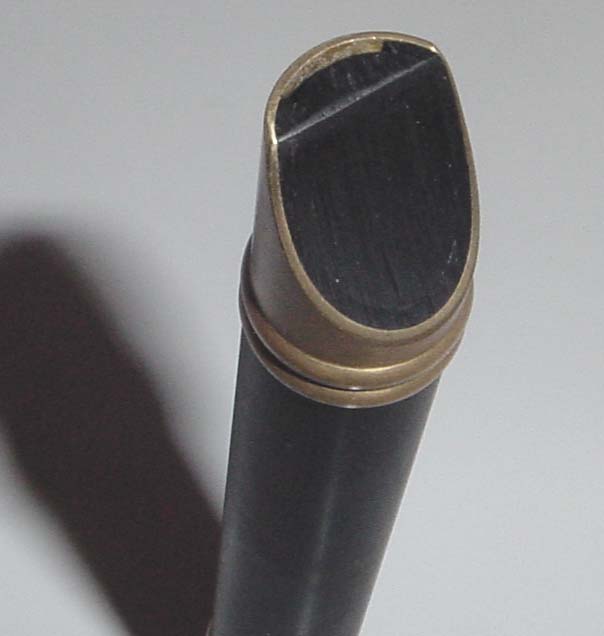
Here's another angle on the mouthpiece, showing the fipple area.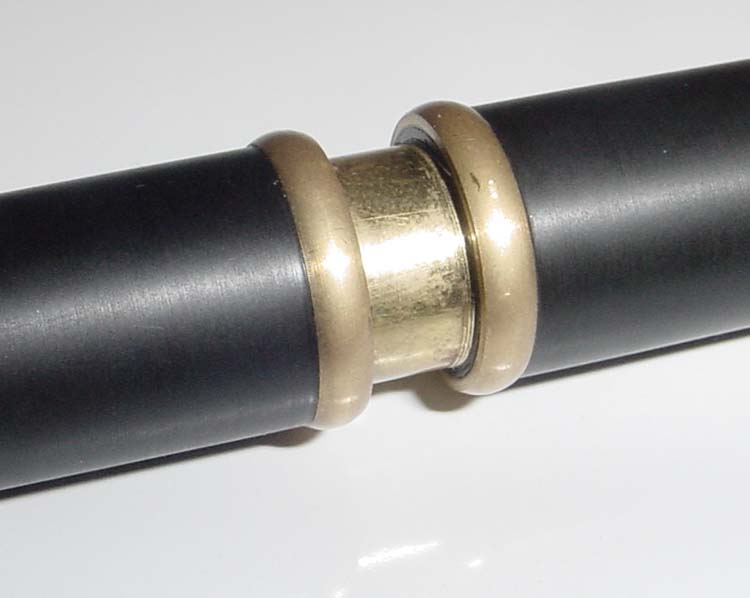
Typical Busman tuning slide. The slide itelf is a little loose until the whistle is all the way closed. Then it tightens up enough. I have had this same issue with Thin Weasels and the other Busman I owned, and Glenn mentioned to me that his slides tend to "break in just before they go out", so it's likely just the way this type of slide is made. Paul has mentioned to me in the past that he has a special tool he can use to snug up the slide if yours gets loose, so be sure and contact him if you end up needing to!
A shot at the end of the whistle, showing the D, E, and F# holes. Since the bottom C hole is a little further away, I wasn't happy with the picture I took that tried to include it. You can see the kind of gouged look to the holes that I was referring to above. They're definitely not very clean looking.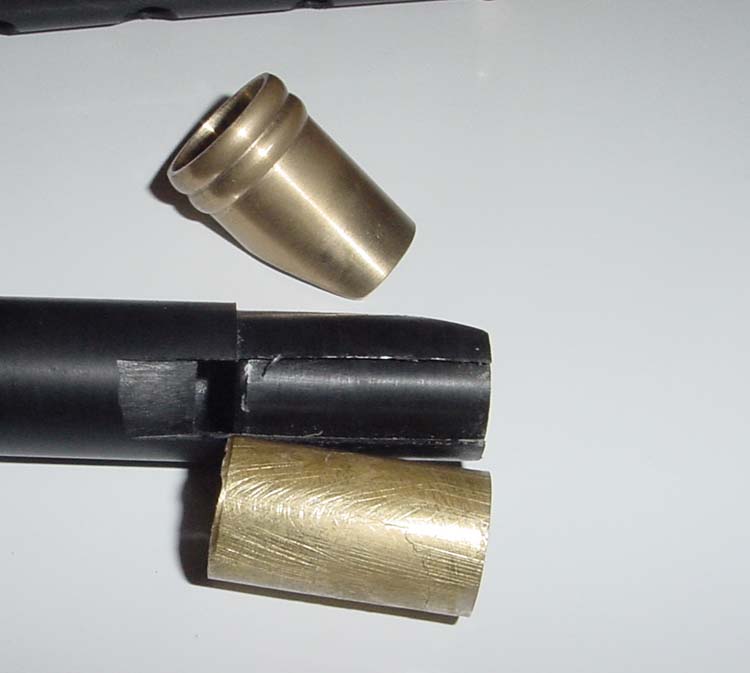
Pictures showing where the glue failed on this whistle. The top brass piece is obviously the mouthpiece. The bottom brass piece is the internal section of the tuning slide. That's the part that is supposed to stay inside the body.
- Playing Characteristics
- Extremely strong tone, especially at the bell note. Pure, with the barest hint of a whisper in the tone to keep things interesting. Sounds a little shrill to me in the second ocatve G, A and B.
-
Sound clips of the whistle:
Flowers of EdinburghVolume: Loud. Just a shade quieter than my Copeland.
Responsiveness: Fast. It sounds a little choppy cutting the high octave D, but a number of whistles I've tried with higher back pressure can do that. I usually solve it by venting the high D when I cut, but didn't do it in the recording, so you could hear it.
Tuning: The intonation on this whistle isn't the greatest. In the first octave, the E and the G have to be played with a bit lighter breath to be in tune, and the F# has to be really pushed. In the second octave has similar breath requirements, and additionally the B is about 25 cents flat, no matter how hard I push it. I could play this with others once I got used to the breath, but I'd have to avoid any tunes that hit the second octave B. At that volume, you really don't want to be 25 cents flat from the musicians around you!
This is a D+ whistle meaning that there's a seventh hole played by the pinkie of the bottom hand. If you ignore that hole, the whistle plays like a D no problem. Cover it, and it will play a C, for those odd songs that need it. This one plays the C about 22 cents flat. That's pushing it near the octave jump. At the expected breath, it's closer to 28 cents flat.
C-natural: OXXOOO plays a C-natural that's absolutely perfect with the expected breath.
Hole size and placement: Except for the extra 7th hole, the hole are centered on the whistle body, and fairly evenly spaced. The D hole is a little larger than average, but about the same size as the E hole, so it didn’t give me any difficulties. The bottom C hole is a little further down, and offset for easier reach. Since I play leftie, it's offset the wrong way for me, making playing it awkward. You'd want to be sure and let Paul know if you needed it offeset for lefties when ordering. Because the whistle is longer than a normal D, and has an extra hole, it was a bit akward to play at first until I got used to the way it felt in my hands. I got used to it pretty quickly though.
Air volume requirements: Average. I don't really find myself noticing that I can go a long distance without breathing, or having to take a breath sooner than normal.
Air pressure requirements: medium to high in the 2nd octave. You have to really push to keep this whistle happen in the high A and B. This is a lot more like the harder blowing Thin Weasels I've tried than the Cocobolo Busman I had a while couple of years ago.
Clogging: Being acetal, I was surprised to find this whistle clogged quickly. And it doensn't take much to make the whistle cut out. I'd definitely want to give this whistle the Duponol treatment if I were keeping it.
Wind Resistance: Low. This whistle plays in a breeze, but anything above that and it cuts right out, especially if it's a cross wind (rather than being at your back).
- Summary
- This whistle sounds good to me, and it has an excellent, strong tone. I'm sure I could get used to the breath requirements if I were keeping it. But, the second octave B being flat means that there are at least a few session tunes I wouldn't want to play with it. It couldn't be the only whistle in my gig bag. The high volume and air pressure required may make beginners shy away from it.